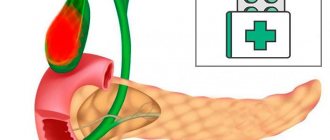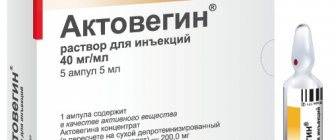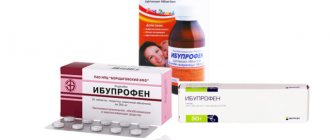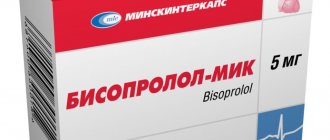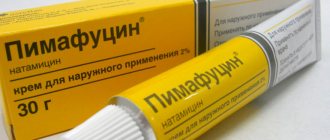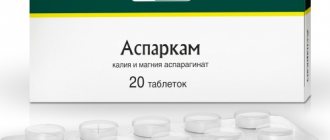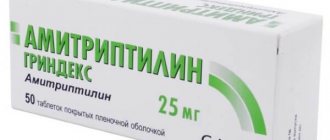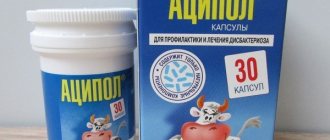special instructions
Abuse of caffeine-containing products during treatment with Citramon can provoke overdose symptoms.
Elderly people, people suffering from gout, impaired renal and/or liver function with benign hyperbilirubinemia should be careful when taking tablets.
In patients with allergic complications (allergic rhinitis, asthma, urticaria), when they are combined with respiratory tract infections, as well as with increased sensitivity to NSAIDs during treatment, bronchospasm or asthma attacks are possible.
With long-term (more than five days in a row) use of Citramon, monitoring of the functional state of the liver and peripheral blood patterns is necessary.
Long-term use of tablets containing paracetamol in high cumulative doses in some cases can cause drug-induced nephropathy or irreversible renal failure.
Long-term use of painkillers to treat headaches often leads to chronic headaches.
Taking Citramon can distort laboratory test indicators such as: plasma concentration of uric acid, plasma concentration of heparin, plasma concentration of theophylline, blood sugar level, concentration of amino acids in the urine.
The drug may alter doping control tests in athletes. It complicates the diagnosis of “acute abdomen”.
In case of long-term treatment with Citramon, you should consult a doctor before taking Ibuprofen.
The use of drugs containing ASA during surgical interventions (including dental operations) increases the likelihood of the occurrence/intensification of bleeding.
The drug may affect the rate of neuromuscular transmission, and therefore during the period of treatment they should refrain from driving a vehicle or operating dangerous machinery.
Headaches are a fairly common occurrence in people prone to changes in blood pressure. Therefore, questions naturally arise here: is it possible to take the medicine with high blood pressure, is the drug harmful for hypotensive patients, how are Citramon and blood pressure related?
The analgesic effect for headaches is provided primarily due to the presence of ASA and paracetamol in the tablets.
The third component of the drug - caffeine - increases the flow of oxygen to tissues, stimulates blood circulation in the brain and increases blood pressure, thus helping to reduce the intensity of headaches and enhancing the effects of other components of Citramon.
High doses of caffeine provoke depression of the central nervous system. When taking small doses (as, for example, in Citramon), the stimulating effect predominates.
It should be noted that while caffeine increases blood pressure, which is reduced during hypotension, it does not change normal blood pressure.
https://www.youtube.com/watch?v=ytpress
With long-term use of the drug, the patient must regularly undergo a blood test to count platelets, a stool test for hidden bleeding, check the condition of the liver and monitor blood pressure. It should be remembered that the medicine contains caffeine, so taking similar drugs with its participation can provoke an overdose.
The pills can interfere with doping control results in athletes and complicate the diagnosis of acute abdominal syndrome. The use of drugs based on acetylsalicylic acid is prohibited before surgery or dental surgery, due to an increased risk of bleeding.
Peculiarities
Before treatment, you need to read the annotation for the drug, and also pay attention to certain nuances:
- Long-term use of this medication requires regular laboratory monitoring of the functional state of the liver and kidneys.
- Before surgery, patients should take the medication off as it reduces blood clotting.
- People with allergies can use the product with extreme caution.
- Long-term use of Citramon can cause a decrease in the excretion of uric acid from the body.
- The active substances of the drug may interact with drugs from other pharmacological groups, so it is important to warn a specialist about their possible use.
- "Citramon" does not have a direct effect on the functional state of the central nervous system.
The drug can be bought in pharmacies without a doctor's prescription. Before use, consultation with a specialist is required.
Compound
According to data provided on Wikipedia, traditionally Citramon tablets included 240 mg of acetylsalicylic acid (ASA), 180 mg of phenacetin, 30 mg of caffeine, 15 mg of cocoa, 20 mg of citric acid.
However, at present, the classic recipe for making the drug is not used due to the withdrawal of one of its active components, phenacetin, from circulation (this is due to the high nephrotoxicity of the substance).
Numerous manufacturers produce medicines whose names contain the word “Citramon”, but they all have a slightly modified composition, in which Paracetamol is used as an analgesic and antipyretic instead of phenacetin.
Tablets from different manufacturers maintain the same uniformity of active ingredients, but the concentration of each of them may differ.
In the composition of Citramon P, Citramon U and Citramon M, the active components (ASA, paracetamol and caffeine), for example, are contained in the same concentration as in the original drug. But in the composition of Citramon-Forte, their concentration is different: each tablet contains 320 mg of ASA, 240 mg of paracetamol, 40 mg of caffeine.
Citramon Borimed tablets contain 220 mg of ASA, 200 mg of paracetamol and 27 mg of caffeine. The concentration of these substances in Citramon-LekT tablets is, respectively, 240 mg, 180 mg and 27.5 mg.
But the main difference between Citramon Ultra and Citramon is the presence of a film shell, which makes the tablet easier to swallow, acts as a reliable barrier between the mucous membrane of the digestive canal and the active substances contained in the tablets (in particular, the shell protects the stomach from the aggressive effects of ASA) and accelerates the absorption of the drug.
Alcohol compatibility
Many people wonder how Citramon and alcohol are compatible with each other. The instructions for use do not indicate what effect the combined use of these substances has. It would seem that the analgesic effect that these tablets have can also relieve a hangover headache. However, many years of research prove that the content of active ingredients in 1-2 tablets is not enough to relieve a hangover. And an overdose is fraught with complications for internal organs.
If you take citramon for a hangover, you may experience:
- Severe gastrointestinal upset. Taking even 1 tablet can cause vomiting, diarrhea, and severe nausea. If a person already has gastrointestinal diseases (gastritis, duodenal or stomach ulcers), the components of the drug may cause bleeding. Citramon slows down blood clotting, so such an exacerbation of the digestive system is quite predictable.
- Toxic liver damage. A one-time dose of Citramon after an alcoholic libation may not cause harm to the liver. However, if this habit becomes part of the system, negative consequences cannot be avoided.
- Allergy. Under the influence of salicylates of the drug in combination with alcohol, urticaria, itching, and in severe cases, Quincke's edema or anaphylactic shock, which sometimes lead to death, may appear.
- Critical decrease in blood sugar. Taking Citramon tablets after alcohol increases the risk of exacerbation of all endocrine diseases, including diabetes.
- A sharp rise in pressure. Alcohol itself increases blood pressure, especially if taken beyond the safe limit. Caffeine and paracetamol can increase readings by several tens of units, up to the occurrence of a hypertensive crisis. Therefore, you should absolutely not use this drug if you have high blood pressure.
Treating a hangover with Citramon can lead to stomach upset
Considering all the negative consequences that can be caused by consuming Citramon with alcohol, you need to think more than once whether it is worth doing. There are other, more effective and safe, drugs to relieve hangover headaches.
During pregnancy
During pregnancy, you should avoid taking Citramon tablets, since the ASA they contain has a teratogenic effect.
The use of Citramon during pregnancy in the 1st trimester can cause cleft palate; the use of the drug in the 3rd trimester leads to a deterioration in labor (suppression of Pg synthesis) and closure of the ductus arteriosus in the fetus. This in turn provokes hyperplasia of the pulmonary vessels and increased pressure in the vessels of the pulmonary (pulmonary) circulation.
Thus, the answer to questions like “Can I drink Citramon during pregnancy?” and “Can pregnant women take Citramon?” unambiguous - impossible.
The use of the drug during hepatitis B is contraindicated. The active components of the tablets and their metabolites are excreted into breast milk, which increases the likelihood of platelet dysfunction and bleeding in the baby.
Use of the drug in the first trimester of pregnancy leads to cleft palate in the child, and in the third trimester to inhibition of labor and hyperplasia of the pulmonary vessels of the fetal pulmonary circulation. Citramon passes into breast milk. Its use during lactation can cause impaired platelet function in the child and the occurrence of bleeding.
Use during menstruation
Citramon quite effectively helps to cope with various manifestations of premenstrual syndrome, often accompanied by discomfort in different parts of the body. This drug may relieve frequent period pain.
In addition to migraines and VSD, which appear during menstruation, it is also recommended to use Citramon for unpleasant pulling sensations in the lower abdomen. Also, thanks to its stimulating effect, it can help with general weakness and drowsiness that accompany the menstrual cycle.
In childhood
Attention! The use of citramon in pediatric practice (in children under 15 years of age) is strictly prohibited due to the possibility of developing Reye's syndrome.
For special cases, the doctor prescribes a child dosage, but not earlier than 2 years of age.
| Age | Dosage, table. |
| 5 | 1/4 |
| 7 | 1/3 |
| 11 | 1/2 |
For example, citramon is given to children with febrile and pyretic fever that cannot be treated with other antipyretics.
The medication should be used under the strict supervision of a specialist.
A life-threatening complication is Reye's syndrome, a brain disorder associated with toxic liver damage caused by taking acetylsalicylic acid.
Symptoms of the condition:
- repeated vomiting;
- refusal to eat;
- irritability alternating with excitement and lethargy;
- disorientation in time and space.
Urgent hospitalization in the intensive care unit is indicated.
According to the instructions, the drug can be used from the age of 15. In young children, tablets can provoke Reye's syndrome, cause serious damage to the central nervous system and liver dysfunction, suppress platelet synthesis and cause hemorrhagic diathesis. In addition, ASA negatively affects the gastric mucosa of children.
What is a contraindication for use?
It is strictly forbidden to take the drug in the presence of the following diseases and pathological conditions:
- stomach ulcer;
- hemophilia;
- blood diseases that affect the speed and degree of blood clotting;
- individual intolerance to the components of the drug;
- diathesis of hemorrhagic type;
- hypertension;
- liver failure;
- severe kidney disease;
- cardiac ischemia.
Relative contraindications: Citramon is not recommended to be taken 2 weeks before a planned operation, or for children under 15 years of age.
Pharmacodynamics and pharmacokinetics
Pharmacodynamics
https://www.youtube.com/watch?v=upload
Citramon is a combined drug, the effect of which is determined by the properties of the components it contains (non-narcotic analgesic, psychostimulant and NSAID).
ASA relieves fever and inflammation, relieves pain (especially if the pain is caused by an inflammatory process), has a moderate antiplatelet effect, prevents the formation of blood clots, and helps improve microcirculation in the area of inflammation.
Paracetamol reduces the intensity of pain, reduces fever, and has a weak anti-inflammatory effect. The properties of this substance are associated with its influence on the thermoregulation center located in the hypothalamic region and a weakly expressed ability to inhibit the formation of Pg in peripheral tissues.
Caffeine has a direct stimulating effect on the central nervous system, which manifests itself in the form of increased excitation processes in the cerebral cortex, vasomotor and respiratory centers, increased motor activity and strengthened positive conditioned reflexes.
Stimulates mental activity, temporarily reducing or eliminating drowsiness and fatigue, and shortens reaction time. Reduces platelet aggregation.
Citramon tablets contain caffeine in low concentrations. Because of this, the substance has virtually no stimulating effect on the central nervous system, but improves cerebral vascular tone and helps accelerate blood flow.
The combination of ASA and paracetamol potentiates the analgesic effect of the drug. Both the analgesic and antipyretic effects of ASA and paracetamol are enhanced when these substances are used simultaneously with caffeine.
Pharmacokinetics
After oral administration, the components contained in the tablets are absorbed quickly and almost completely. At the same time, caffeine helps to increase F (bioavailability) of ASA and paracetamol.
During absorption, it and ASA are intensively biotransformed with the formation of pharmacologically active metabolites. Salicylic acid is formed from ASA in the process of deacetylation in the liver and intestinal wall.
Under the influence of the hepatic isoenzyme CYP1A2, caffeine forms dimethylxanthines (paraxanthine and theophylline).
The maximum duration of all active components of Citramon is from 0.3 to 1 hour. In the blood plasma, from 10 to 15% of paracetamol and approximately 80% of the taken dose of ASA are in an albumin-bound state.
All components of the tablets easily penetrate into any fluids and tissues of the body (including easily crossing the placental barrier and entering breast milk). Minor concentrations of salicylates are found in brain tissue, while levels of caffeine and paracetamol are comparable to plasma levels.
With the development of acidosis, ASA turns into a non-ionized form, due to which its penetration into the tissues of the NS increases.
Metabolism of active substances occurs in the liver. ASA has 4 metabolites (gentisuronic and gentisic acids, salicylophenolic glucuronide, salicylurate). Paracetamol forms sulfate (80% of the total amount) and paracetamol glucuronide (both are pharmacologically inactive), as well as a potentially toxic substance - N-acetyl-benziminoquinone (about 17% of the total amount).
Caffeine metabolites are uridine derivatives, mono- and dimethylxanthines, mono- and dimethyluric acid, di- and trimethylallantoin.
Caffeine affects the pharmacokinetics of paracetamol, slightly increasing (up to 20-25%) the formation of N-acetyl-benziminoquinone.
Metabolites are excreted by the kidneys. About 5% of paracetamol, about 10% of caffeine and about 60% of salicylates are excreted unchanged.
The half-life of elimination is from 2 to 4.5 hours (all components of the drug are excreted at approximately the same rate). Increasing the dose of Citramon leads to a slower elimination of ASA compared to other substances by up to 15 hours.
In smokers, on the contrary, there is an accelerated elimination of caffeine in comparison with other components of the drug.
Composition of the drug and pharmacological properties
Citramon is a combination medicine. Includes 3 main components for a more effective impact on the root cause of pain:
- aspirin (the element quickly minimizes fever, relieves acute inflammation, increases blood microcirculation, relieves headaches);
- paracetamol (has a pronounced antipyretic effect, headaches under the influence of the substance are quickly minimized);
- caffeine (acts as a kind of amplifier of the action of the other two components of the drug, has a tonic effect, relieves acute pain in the head).
Citramon is a non-narcotic analgesic, a combined composition, which ensures a wide spectrum of action of the drug. The main active ingredient is acetylsalicylic acid, which has an antipyretic and analgesic effect, thins the blood, and relieves unpleasant symptoms of colds and viral diseases.
Caffeine - expands the bloodstream, has a stimulating effect on the psychomotor centers in the brain, eliminating symptoms such as lethargy and drowsiness. Paracetamol is another active component of the drug, which, along with the analgesic effect, can relieve the inflammatory process.
The drug begins to act 10-20 minutes after administration, the peak activity of the components occurs after 1-2 hours. Citramon is excreted from the body through the kidneys and urine.
Drug interactions
https://www.youtube.com/watch?v=https:tv.youtube.com
Citramon tablets must be combined correctly with other medications, otherwise complications and unforeseen situations may arise. Eg:
- the drug enhances the effect of heparin, reserpine, steroid hormones, indirect anticoagulants and hypoglycemic agents;
- simultaneous use of tablets with methotrexate or other non-steroidal anti-inflammatory drugs increases the risk of side effects;
- when interacting with furosemide, gout medications, antihypertensive tablets, their effectiveness decreases;
- rifampicin, barbiturates, anti-epileptic drugs and salicylamide provoke the release of toxic metabolites of paracetamol, which negatively affect the liver;
- when used simultaneously with metoclopramide, the absorption time of paracetamol is reduced;
- Citramon may enhance the effect of anticoagulants;
- taking paracetamol and ethanol increases the risk of hepatotoxic effects.
It is strictly forbidden to prescribe in combination with Citramon with:
- MAO inhibitors (when used simultaneously with caffeine, these drugs can lead to a dangerous increase in blood pressure);
- methotrexate at a dose exceeding 15 mg/week. (this combination increases the hematological toxicity of methotrexate).
Citramon also enhances the toxicity of barbiturates and valproic acid, the effects of opioid analgesics, oral hypoglycemic and sulfonamide agents, digoxin and triiodothyronine.
Phenytoin, ethanol, COCs, Rifampicin, tricyclic antidepressants, barbiturates, phenylbutazone increase the toxicity of paracetamol to the liver.
Macrolides (Erythromycin, Clarithromycin), interferon preparations, antimycotic agents (Fluconazole, Ketoconazole) slow down the metabolism of the active substances of Citramon tablets and lead to an increase in their concentration in plasma.
The use of the drug in combination with platelet aggregation inhibitors, indirect anticoagulants and thrombolytic agents increases the risk of bleeding.
By inhibiting the synthesis of Pg in the kidneys, it weakens the effect of potassium-sparing and loop diuretics, as well as antihypertensive drugs from the group of ACE inhibitors.
GCS increase the toxicity of the components of the tablets on the gastric mucosa, increase the clearance of ASA and reduce its plasma concentration.
In combination with beta-adrenergic agonists (Fenoterol, Salbutamol, salmeterol) in high doses, the risk of developing hypokalemia increases; with methylxanthines, the level of theophylline in plasma increases and the risk of its toxic effect increases; with Li salts, the plasma concentration of Li ions increases.
https://www.youtube.com/watch?v=ytdev
Due to the competitive excretion of uric acid in the nephron tubules, it weakens the effect of uricosuric drugs.
Painkiller injections
The most radical way to get rid of menstrual pain. They help quickly, within 10-15 minutes, since the active substance of the drug enters almost directly into the blood, bypassing the gastrointestinal tract. In order to correctly administer an intramuscular or intravenous injection of the drug, a medical professional is required. It is not advisable to give yourself injections yourself. because you can get into a nerve.
Which pills for menstrual pain are best to choose if it is not possible to give injections? The list of the most potent drugs and the list of the mildest drugs are just below.
For severe antispasmodic pain, some drugs are weak. Which pills are most effective for menstrual pain? Here is a list of the most powerful tablet drugs:
- The complex analgesic "Spazmalgon" consists of several active elements: a non-steroidal anti-inflammatory drug, an antispasmodic and a substance that enhances their effect. By inhibiting prostaglandins and reducing the release of calcium into smooth muscle cells, an effective and rapid reduction in spasms is achieved and relief from pain occurs. The effect occurs approximately 15-20 minutes after taking the tablet. To make the pain go away as quickly as possible, it is not recommended to take Spazmalgon tablets for menstrual pain immediately after eating.
- Tramal is a prescription drug. Has a powerful anesthetic effect. Affects opioid receptors. Able to block areas of the brain that are responsible for the sensation of pain. Causes drug dependence. This drug can only be used in cases where no other remedy helps.
- Promedol is another powerful drug for pain. Sold by prescription as it is a potent opioid. With constant use it is highly addictive. The principle of action of this drug is similar to Tramal.
- "Ketanov" - tablets for menstrual pain, belong to the class of NSAIDs. This is the most powerful analgesic among non-steroidal anti-inflammatory drugs. This medicine is used not only for pain in the lower abdomen due to menstruation, but also after surgery, migraines, cancer pain and other unbearable pain.
The tablet drug "Tamipul" is a complex drug with analgesic and anti-inflammatory activity. Most often it is prescribed specifically for the relief of menstrual pain. It is practically free of side effects and has little toxic effect on internal organs.
The drug can also be used by children from the age of twelve. So for primary algodismenorrhea, this remedy is perfect.
Contraindications
When asked what Citramon P helps with, the manufacturer answers in the annotation for the drug that the use of tablets is advisable for relieving mild to moderate pain, as well as for alleviating the patient’s condition during febrile syndrome, which is accompanied by ARVI and influenza.
Citramon is effective for the head (including during migraine attacks), for joint and muscle pain, and algodismenorrhea.
Indications for the use of Citramon-LekT are the same as for other drugs based on ASA, paracetamol and caffeine, namely: pain syndrome due to algodismenorrhea, neuralgia, myalgia, arthralgia, headache, toothache, migraine.
The drug can also be used as a remedy for fever during acute respiratory viral infections and influenza.
Toothache is one of the indications for using the drug. The effectiveness of Citramon is due to the properties of its constituent NSAIDs, non-narcotic analgesics and psychostimulants.
Strengthening each other's action, these components have a complex effect on the body, relieving any pain (including toothache), especially if it is associated with inflammation. During exacerbation of chronic pulpitis, which often causes a rise in temperature, Citramon not only helps relieve pain and reduce the severity of inflammation, but also has an antipyretic effect.
The instructions list the following contraindications for Citramon:
- complete or partial combination of recurrent nasal polyposis/paranasal sinuses, bronchial asthma and intolerance to NSAIDs or ASA (including a history);
- hypersensitivity to the components of the tablets;
- erosive and ulcerative lesions of the gastrointestinal tract in the acute phase;
- stomach or intestinal bleeding;
- portal hypertension;
- hemophilia;
- hypoprothrombinemia;
- hemorrhagic diathesis;
- vitamin deficiency K;
- Severe ischemic heart disease;
- severe arterial hypertension;
- renal failure;
- deficiency of the cytosolic enzyme G6PD;
- pregnancy (especially its first and last trimesters);
- lactation;
- increased excitability;
- glaucoma;
- dissecting aortic aneurysm;
- sleep disorders;
- surgical interventions accompanied by bleeding;
- children's age (in children under fifteen years of age with hyperthermia against the background of a viral infection, there is a high probability of developing Reye's syndrome);
- concomitant use of anticoagulants.
Relative contraindications are gout and existing liver pathologies.
The drug is not prescribed to children under 15 years of age and pregnant women. In addition, citramon is contraindicated:
- with hypersensitivity to the components of the drug;
- glaucoma;
- hemophilia;
- with gastrointestinal lesions;
- presence of bleeding;
- bronchial asthma;
- liver diseases;
- arterial hypertension;
- hypoprothrombinemia;
- increased excitability;
- sleep disorders;
- vitamin deficiency;
- before surgical operations.
Taking the drug by pregnant women and during lactation
The drug is contraindicated during pregnancy and lactation.
The drug is contraindicated for children.
Citramon is prohibited for use by pregnant women in the 1st and 3rd trimester. A relative contraindication is the period of breastfeeding. If it is necessary for a woman who is breastfeeding to take the medicine, lactation must be temporarily canceled, while regularly expressing milk without using it to feed the baby.
In the early stages of the gestational period, taking the drug can lead to uterine hypertonicity, bleeding, and miscarriage. In later stages, systematic use of the drug often provokes weak labor. For the fetus, regular use of Citramon by the mother is fraught with further premature closure of the fontanel.
Side effects
As a rule, when taking Citramon according to the instructions or recommendations of a doctor, negative reactions of the body do not occur; the following rarely appears:
- anorexia;
- erosive and ulcerative lesions;
- nausea;
- bronchospasms;
- allergic reactions;
- gastralgia;
- epidermal necrolysis;
- exudative epithema;
- dizziness;
- gastrointestinal bleeding;
- increased blood pressure and tachycardia;
- noise in ears.
Side effects of Citramon:
- gastralgia, anorexia, nausea, formation of erosions and ulcerative elements on the mucous membrane of the digestive canal, gastric and intestinal bleeding;
- liver failure;
- hypersensitivity reactions (including the development of symptoms of the Fernand-Vidal triad);
- interstitial nephritis, nephrotic syndrome, necrotizing papillitis, with long-term use - renal failure;
- anemia, thrombocytopenia, leukopenia;
- acute fatty hepatosis, toxic hepatitis, acute hepatic encephalopathy (Reye's syndrome);
- worsening heart failure, manifestation of its latent forms (with long-term use);
- dizziness, insomnia, agitation, anxiety, headache, tinnitus, hearing and vision impairment, aseptic meningitis;
- increased blood pressure, arrhythmia, tachycardia;
- development of tolerance and weak psychological dependence (with long-term use of high doses of the drug);
- drug-induced headache after discontinuation of Citramon (if the drug was used for a long time).
Experiments on animals also demonstrated the teratogenic effect of the drug on the fetus.
Indications
"Citramon" brings down the temperature? The main medical indication for the use of tablets is the symptomatic treatment of fever and pain of inflammatory etiology in various pathologies:
- Toothache.
- Migraine.
- Heat.
- Algodysmenorrhea (pain during menstruation, resulting from improper position of the uterus, inflammatory processes in the genitals, endometriosis and other diseases).
- Myalgia (a disease of muscle tissue, which is accompanied by acute or dull pain in both tense and relaxed states).
- Arthralgia (transient joint pain in the absence of objective symptoms of joint damage).
- Neuralgia (pathology that progresses as a result of damage to certain parts of the peripheral nerves).
In addition, the medication is used to reduce the severity of discomfort during painful periods in women.
Overdose
If you use pills haphazardly, the following symptoms may occur:
- Mild intoxication – vomiting, nausea, tinnitus, dizziness, stomach pain.
- Severe poisoning – drowsiness, collapse, convulsions, inhibition of reactions, bleeding, coma, anuria, difficulty breathing, respiratory acidosis. With further use of the medicine, irreversible liver damage and kidney dysfunction may occur.
A slight overdose manifests itself in the form of nausea, dizziness, increased pallor of the skin, gastralgia, vomiting, and ringing in the ears.
Symptoms of severe intoxication of the body: impaired circulation and breathing, anuria, anxiety, stupor, nausea, headache, hyperthermia, tremor, drowsiness, anxiety, sweating, collapse, bleeding, convulsions (with pathological increased tendon reflexes), coma.
https://www.youtube.com/watch?v=https:accounts.google.comServiceLogin
If signs of overdose appear, taking the tablets should be stopped. To prevent the absorption of the drug in the digestive canal, the patient's stomach is washed, enterosorbents and a saline laxative are given.
If the plasma concentration of salicylates in a child exceeds 300 mg/l, and in an adult - 500 mg/l, it is advisable to carry out forced alkaline diuresis. To maintain urine pH at 7.5-8, alkalizing agents are administered.
Measures are taken to restore the bcc and acid-base balance.
In case of cerebral edema, mechanical ventilation with an oxygen-enriched mixture is prescribed in the mode of creating PEEP (positive end-expiratory pressure). Hyperventilation should be carried out in combination with the use of osmotic diuretics.
If there are signs of liver damage, N-acetylcysteine, which is a specific antidote to paracetamol, should be administered. The solution is used orally and injected into a vein. In total, the patient needs to administer seventeen doses: the first - 140 mg/kg, all subsequent doses - 70 mg/kg.
The most effective therapy is started in the first ten hours after the development of intoxication. If more than 36 hours have passed, treatment is ineffective.
When the prothrombin index (PTI) value increases to 1.5-3, the use of phytomenadione (vitamin K) in a dose of 1 to 10 mg is indicated. If the PTI exceeds 3.0, infusion of clotting factor concentrate or native plasma should be started.
Conducting hemodialysis, using antihistamines, corticosteroids or acetazolamide (to alkalinize urine) during intoxication with Citramon is contraindicated.
These measures can provoke the development of acidemia and enhance the toxic effect of ASA on the patient’s body.
For a hangover
Nausea, headache, and a whole list of negative symptoms are combined into one name - “hangover”. The medicine may help:
- deterioration of health;
- increased toxic effects.
The most well-known versions of this medicine contain 2 pain-relieving components, which are not recommended to be used in high concentrations in case of severe hangover:
- Paracetamol has a harmful effect on the liver.
- Acetylsalicylic acid increases the risk of bleeding.
When Citramon is combined with alcoholic drinks, a “mixture” is obtained that can seriously harm the body.
Citramon tablets: instructions for use
Preparations from different manufacturers have different compositions, and since they often contain active substances in different concentrations, you should read the instructions very carefully so as not to mistakenly exceed the permissible daily dose.
What all drugs have in common is that they can be used as an analgesic for a maximum of five days, and as an antipyretic for three days.
Citramon P and Citramon-LekT can be taken from the age of fifteen. Take one tablet 2-4 times a day (during or after meals). The break between doses should be at least four hours. The average dose is 3-4 tablets per day.
Citramon for high-intensity headaches (as well as in other cases when it is necessary to relieve severe pain) can be taken 2 pieces at once. The permissible upper limit of the daily dose is 8 tablets.
Treatment lasts from one week to ten days.
If necessary, the doctor may prescribe a different dose of the drug or select a different treatment regimen.
Citramon-Forte is used in patients over sixteen years of age. The daily dose is 2-3 tablets. You need to take them one at a time, 2 or 3 times a day. To relieve an attack of acute pain, you should immediately take two tablets.
The permissible upper limit of the daily dose is 6 tablets.
Citramon-Darnitsa is taken according to a similar regimen (the only difference between the drug is the age limit - these tablets are prescribed from 15 years of age).
It is preferable to take Citramon-Borimed immediately after meals or between meals. The drug can be used in adults and adolescents over fifteen years of age. Take one tablet 2-3 times a day, maintaining intervals of at least 6-8 hours between doses. The highest single dose is 2 tablets, the daily dose is 4.
It is used as an antipyretic at temperatures exceeding 38.5°C (if there is a tendency to febrile convulsions - at temperatures above 37.5°C). Single dose - 1-2 tablets.
Citramon Ultra is prescribed from the age of fifteen. Daily dose - 1-3 tablets. If necessary, you can take up to 6 tablets during the day.
Heat
As an antipyretic and analgesic, if a patient has a high temperature, the drug is used for a maximum of three days. A small dose supports the patient, improves tone with a general decrease in temperature.
The drug contains acetylsalicylic acid (antipyretic), so Citramon can be drunk at fever. However, it is important to follow the dosage. So, if Citramon helps adults with fever, how many tablets should they take per day?
You are allowed to take no more than 6 tablets per day. Acetylsalicylic acid is widely known as one of the representatives of the group of non-steroidal anti-inflammatory drugs.
It perfectly helps fight high temperatures, instantly returning them to normal values. So, using the drug at fever is more than justified. This has been scientifically proven. In addition, there is Citramon P. Does it help with fever as effectively as regular medication? Yes, they have the same effect on fever.
Citramon price
| Packaging | Manufacturer | Price, in rubles |
| tablets 10 pcs. | Pharmstandard-Leksredstva | 16,00 |
| tablets 20 pcs. | Medisorb | 34,00 |
| No. 6 tablets | Tatkhimpharmpreparaty OJSC | 10,00 |
| No. 20 tab. | Anzhero-Sudzhensky Chemical Plant | 33,00 |
| table contour cells pack / 6 pcs. | JSC Krasnaya Zvezda | 14,00 |
The price of Citramon depends on which company produced the drug. So, for example, the price of Citramon P is from 14, and the price of Ciramon Ultra is from 70 rubles.
https://www.youtube.com/watch?v=cosamomglavnom
In Ukraine, a package of tablets can be purchased for 2.3-15.5 UAH.
- Online pharmacies in RussiaRussia
- Online pharmacies in UkraineUkraine
- Online pharmacies in KazakhstanKazakhstan
ZdravCity
- Citramon p tablets No. 20 Dalkhimfarm JSC Dalkhimfarm
- Citramon p tablets No. 10 Anzhero-Sudzhensky HFZOOO Anzhero-Sudzhensky HFZ
- Citramon p tablets No. 20 Anzhero-Sudzhensky HFZOOO Anzhero-Sudzhensky HFZ
- Citramon p medisorb tab. No. 30 JSC Medisorb
- Citramon p tablets No. 20 Update JSC Update PFK
Pharmacy Dialogue
Europharm* 4% discount using promo code medside11
- Citramon p n10 tab Pharmstandard-Leksredstva OJSC
- Citramon ultra No. 20 tabPharmVilar LLC NPO
- Citramon p reneval No. 20 tableUpdate PFC JSC
- Citramon p No. 20 tabUralbiopharm OJSC
show more
Pharmacy24
- Citramon-M No. 6 tablets PAT "Khimpharmzavod" Chervona Zirka", Kharkov, Ukraine
- Citramon Fitofarm forte N12 capsules PRAT "Fitofarm", Ukraine
- Citramon-M No. 10 tablets PAT "Khimpharmzavod" Chervona Zirka", Kharkov, Ukraine
- Citramon Euro N10 tablets Mibe GmbH Arznam., Germany
- Citramon-forte No. 100 tablets PAT "Lubnipharm", Ukraine
PaniPharmacy
- Citramon In tablet Citramon In tablet. No. 6 Ukraine, Lubnyfarm PJSC
- Citramon F tablets Citramon tablets. No. 6 Ukraine, Fitofarm ChAO
- Citramon M tablets Citramon-M tablets. No. 10 Ukraine, Red Star JSC
- Citramon tablets Citramon-Darnitsa tablets No. 6 Ukraine, Darnitsa ChAO
- Citramon tablets Citramon-Darnitsa tablets No. 10 Ukraine, Darnitsa ChAO
show more
BIOSPHERE
- Citramon-Borimed No. 6 tab. Borisov ZMP (Belarus)
- Citramon P No. 10 tablet. Irbit chemical plant (Russia)
- Citramon U No. 10 tablet Lubnyfarm (Ukraine)
show more
Analogs
If it is impossible to take Citramon due to contraindications or a tendency to allergic reactions, this drug can be replaced with drugs with an identical spectrum of action. Analogues of Citramon: Askofen P, Citramon P, Koficil-plus, Citramarin.
These drugs have a composition and spectrum of action similar to Citramon. All drugs have their own characteristics of use and a list of contraindications, which must be taken into account when choosing an analogue. If it is necessary to select an effective analogue, it is recommended to consult with your doctor.
Citramon has many both Russian and foreign analogues, expensive and cheap.
Askofen-P
- tablets, 10 pcs. – 27 rub.
- tablets, 20 pcs. – 51 rub.
Coficil-Plus
- tablets, 10 pcs. – 9 rub.
Migrenol Extra
- tablets, 8 pcs. – 196 rub.
- tablets, 16 pcs. – 233 rub.
Excedrin
- tablets, 10 pcs. – 159 rub.
- tablets, 20 pcs. – 260 rub.

